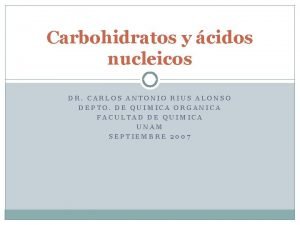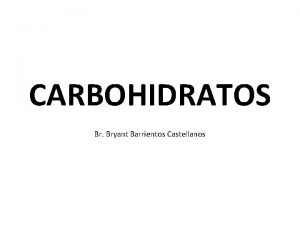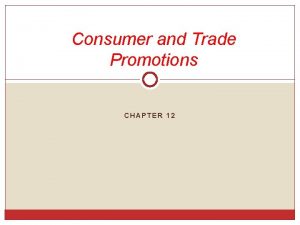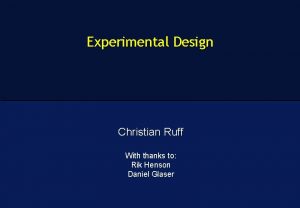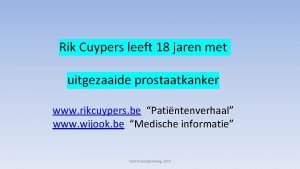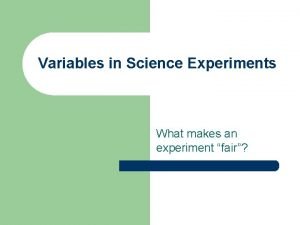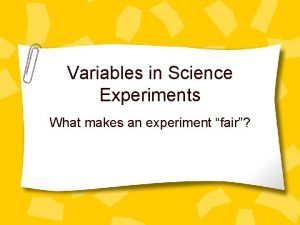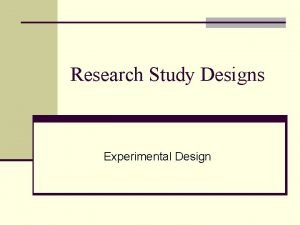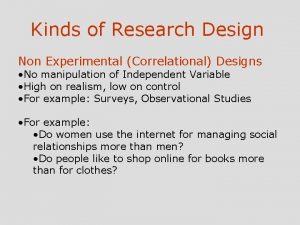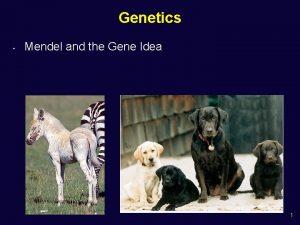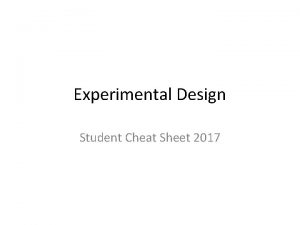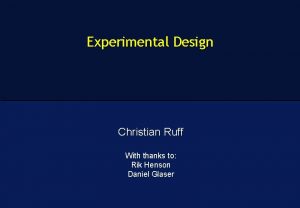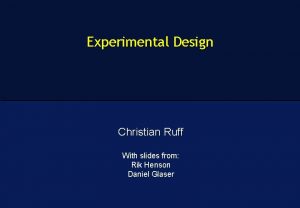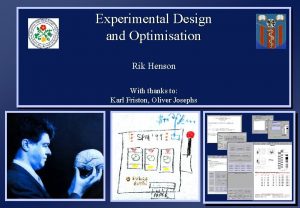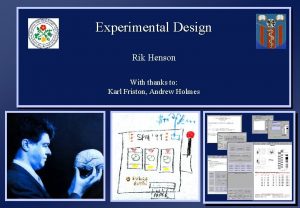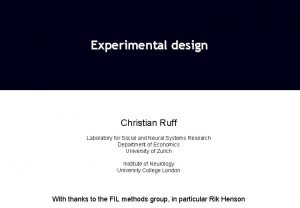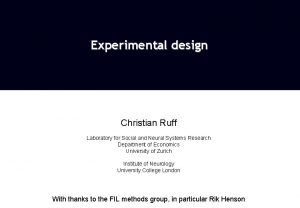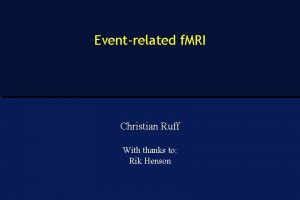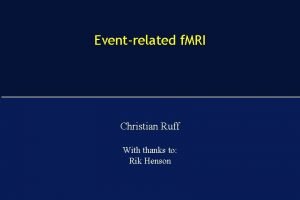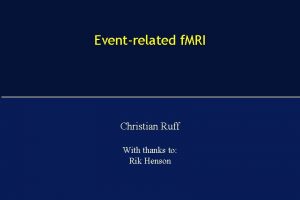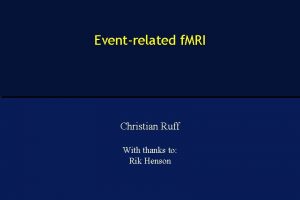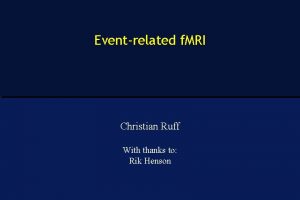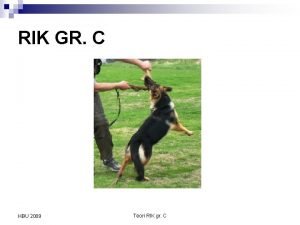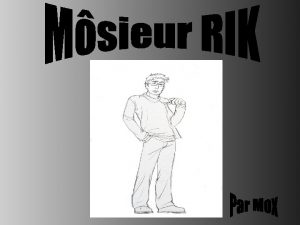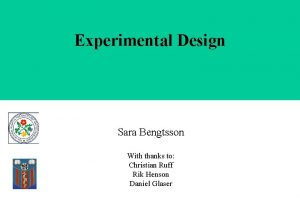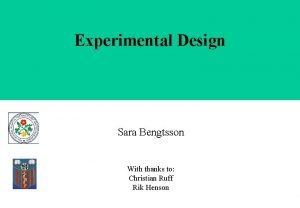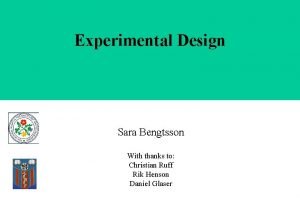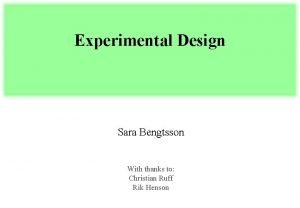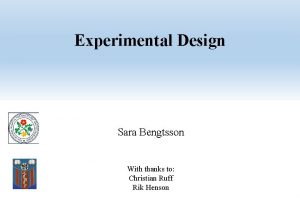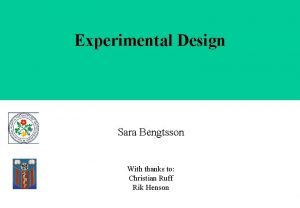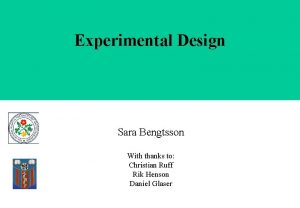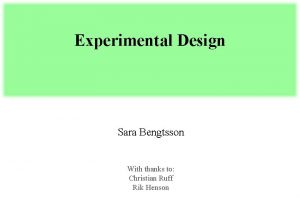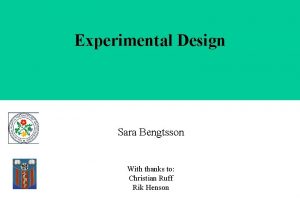Experimental Design Christian Ruff With thanks to Rik





































- Slides: 37

Experimental Design Christian Ruff With thanks to: Rik Henson Daniel Glaser

Image time-series Kernel Design matrix Realignment Smoothing General linear model Statistical parametric map (SPM) Statistical inference Normalisation Gaussian field theory p <0. 05 Template Parameter estimates

Overview • Categorical designs Subtraction Conjunction - Pure insertion, evoked / differential responses - Testing multiple hypotheses • Parametric designs Linear Nonlinear • - Adaptation, cognitive dimensions - Polynomial expansions, neurometric functions Factorial designs Categorical Parametric - Interactions and pure insertion - Linear and nonlinear interactions - Psychophysiological Interactions

Cognitive Subtraction • Aim: – Neuronal structures underlying a single process P? • Procedure: – Contrast: [Task with P] – [control task without P ] = P the critical assumption of „pure insertion“ • Example: – Neuronal structures underlying face recognition? - Neuronal structures computing face recognition?

Cognitive Subtraction: Baseline-problems • „Distant“ stimuli - Several components differ! • „Related“ stimuli „Queen!“ P implicit in control task ? „Aunt Jenny? “ • Same stimuli, different task Name Person! Interaction of process and task ? Name Gender!

Evoked responses Differential event-related f. MRI SPM{F} testing for evoked responses Parahippocampal responses to words • “Baseline” here corresponds to session mean (and thus processing during “rest”) • Null events or long SOAs essential for estimation BOLD EPI f. MRI at 2 T, TR 3. 2 sec. Words presented every 16 secs; (i) studied words or (ii) new words • “Cognitive” interpretation hardly possible, but useful to define regions generally involved in the task

Differential responses Differential event-related f. MRI SPM{F} testing for evoked responses SPM{F} testing for differences BOLD EPI f. MRI at 2 T, TR 3. 2 sec. Words presented every 16 secs; (i) studied words or (ii) new words Parahippocampal responses to words studied words new words Peri-stimulus time {secs}

A categorical analysis Experimental design Word generation Word repetition G R RGRGRG G - R = Intrinsic word generation …under assumption of pure insertion

Overview • Categorical designs Subtraction Conjunction - Pure insertion, evoked / differential responses - Testing multiple hypotheses • Parametric designs Linear Nonlinear • - Adaptation, cognitive dimensions - Polynomial expansions, neurometric functions Factorial designs Categorical Parametric - Interactions and pure insertion - Linear and nonlinear interactions - Psychophysiological Interactions

Conjunctions • One way to minimise the baseline/pure insertion problem is to isolate the same process by two or more separate comparisons, and inspect the resulting simple effects for commonalities • A test for such activation common to several independent contrasts is called “Conjunction” • Conjunctions can be conducted across a whole variety of different contexts: • tasks • stimuli • senses (vision, audition) • etc. • But the contrasts entering a conjunction have to be truly independent!

Conjunctions Naming Colours V R P Viewing A 1 A 2 Objects Visual Processing Object Recognition Phonological Retrieval Task (1/2) Stimuli (A/B) Example: Which neural structures support object recognition, independent of task (naming vs viewing)? B 1 B 2 (Object - Colour viewing) & (Object - Colour naming) [1 -1 0 0] & [0 0 1 -1] [ R, V - V ] & [ P, R, V - P, V ] = R&R =R (assuming no interaction Rx. P; see later) Price et al, 1997 Common object recognition response (R)

Conjunctions

Two flavours of inference about conjunctions • Test of global null hypothesis: Significant set of consistent effects “which voxels show effects of similar direction (but not necessarily individual significance) across contrasts? ” • Test of conjunction null hypothesis: Set of consistently significant effects B 1 -B 2 SPM 5 offers two general ways to test the significance of conjunctions: p(A 1=A 2)<p + + p(B 1=B 2)<p “which voxels show, for each specified contrast, effects > threshold? ” • Choice of test depends on hypothesis and congruence of contrasts; the global null test is more sensitive (i. e. , when direction of effects hypothesised) A 1 -A 2 Friston et al. (2005). Neuroimage, 25: 661 -7. Nichols et al. (2005). Neuroimage, 25: 653 -60.

Overview • Categorical designs Subtraction Conjunction - Pure insertion, evoked / differential responses - Testing multiple hypotheses • Parametric designs Linear Nonlinear • - Adaptation, cognitive dimensions - Polynomial expansions, neurometric functions Factorial designs Categorical Parametric - Interactions and pure insertion - Linear and nonlinear interactions - Psychophysiological Interactions

Parametric Designs: General Approach • Parametric designs approach the baseline problem by: – Varying the stimulus-parameter of interest on a continuum, in multiple (n>2) steps. . . –. . . and relating blood-flow to this parameter • Possible tests for such relations are manifold: • Linear • Nonlinear: Quadratic/cubic/etc. • „Data-driven“ (e. g. , neurometric functions)

A linear parametric contrast Linear effect of time

A nonlinear parametric contrast The nonlinear effect of time assessed with the SPM{T}

Inverted ‘U’ response to increasing word presentation rate in the DLPFC Polynomial expansion: f(x) ~ b 1 x + b 2 x 2 +. . . …up to (N-1)th order for N levels (SPM 8 GUI offers polynomial expansion as option during creation of parametric modulation regressors) SPM{F} Quadratic E. g, F-contrast [0 1 0] on Quadratic Parameter => Linear Nonlinear parametric design matrix

Parametric Designs: Neurometric functions versus Rees, G. , et al. (1997). Neuroimage, 6: 6: 27 -78 Inverted ‘U’ response to increasing word presentation rate in the DLPFC

Parametric Designs: Neurometric functions Coding of tactile stimuli in Anterior Cingulate Cortex: Stimulus (a) presence, (b) intensity, and (c) pain intensity – Variation of intensity of a heat stimulus applied to the right hand (300, 400, 500, and 600 m. J) – Assumptions: Büchel et al. (2002). The Journal of Neuroscience, 22: 970 -6

Parametric Designs: Neurometric functions Stimulus intensity Stimulus presence Pain intensity Büchel et al. (2002). The Journal of Neuroscience, 22: 970 -6

Parametric Designs: Model-based regressors Seymour, O‘Doherty, et al. (2004). Nature.

Overview • Categorical designs Subtraction Conjunction - Pure insertion, evoked / differential responses - Testing multiple hypotheses • Parametric designs Linear Nonlinear • - Adaptation, cognitive dimensions - Polynomial expansions, neurometric functions Factorial designs Categorical Parametric - Interactions and pure insertion - Linear and nonlinear interactions - Psychophysiological Interactions

Factorial designs: Main effects and Interactions Colours Objects Stimuli (A/B) Task (1/2) Viewing Naming A 1 A 2 B 1 B 2 • Main effect of task: (A 1 + B 1) – (A 2 + B 2) • Main effect of stimuli: (A 1 + A 2) – (B 1 + B 2) • Interaction of task and stimuli: Can show a failure of pure insertion (A 1 – B 1) – (A 2 – B 2) interaction effect (Stimuli x Task) Colours Objects Viewing Colours Objects Naming

Interactions and pure insertion Components Visual processing Object recognition Phonological retrieval Interaction V R P Rx. P Interaction (name object - colour) - (view object - colour) [1 -1 0 0] - [0 0 1 -1] = [ P, R, V + Rx. P - P, V ] - [ R, V - V ] = Rx. P adjusted r. CBF Object-naming-specific activations Context: no naming

Interactions and pure insertion Interactions: cross-over and simple We can selectively inspect our data for one or the other by masking during inference

Overview • Categorical designs Subtraction Conjunction - Pure insertion, evoked / differential responses - Testing multiple hypotheses • Parametric designs Linear Nonlinear • - Adaptation, cognitive dimensions - Polynomial expansions, neurometric functions Factorial designs Categorical Parametric - Interactions and pure insertion - Linear and nonlinear interactions - Psychophysiological Interactions

Linear Parametric Interaction A (Linear) Time-by-Condition Interaction (“Generation strategy”? ) Contrast: [5 3 1 -1 -3 -5] [-1 1] = [-5 5 -3 3 -1 1 1 -1 3 -3 5 -5]

Nonlinear Parametric Interaction F-contrast tests for nonlinear Generation-by-Time interaction (including both linear and Quadratic components) Factorial Design with 2 factors: 1. Gen/Rep (Categorical, 2 levels) 2. Time (Parametric, 6 levels) Time effects modelled with both linear and quadratic components… G-R Time Lin Time Quad Gx. T Lin Quad

Overview • Categorical designs Subtraction Conjunction - Pure insertion, evoked / differential responses - Testing multiple hypotheses • Parametric designs Linear Nonlinear • - Adaptation, cognitive dimensions - Polynomial expansions, neurometric functions Factorial designs Categorical Parametric - Interactions and pure insertion - Linear and nonlinear interactions - Psychophysiological Interactions

Psycho-physiological Interaction (PPI) Parametric, factorial design, in which one factor is a psychological context …. . . and the other is a physiological source (activity extracted from a brain region of interest) Context X source target

Psycho-physiological Interaction (PPI) Parametric, factorial design, in which one factor is a psychological context …. . . and the other is a physiological source (activity extracted from a brain region of interest) Set stimuli Context-sensitive connectivity Modulation of stimulus-specific responses source target

Psycho-physiological Interaction (PPI) V 1 activity SPM{Z} Attention V 5 Attentional modulation of V 1 - V 5 contribution V 5 activity V 1 time attention no attention V 1 activity

Psycho-physiological Interaction (PPI) 0 0 1 V 1 activity SPM{Z} V 5 activity time attention no attention V 1 activity V 1 Att V 1 x Att

Psycho-physiological Interaction (PPI) SPM{Z} Stimuli: Faces or objects PPC IT adjusted r. CBF Faces Objects medial parietal activity

Psycho-physiological Interaction (PPI) • PPIs tested by a GLM with form: y = (V 1 A). b 1 + V 1. b 2 + A. b 3 + e c = [1 0 0] • However, the interaction term of interest, V 1 A, is the product of V 1 activity and Attention block AFTER convolution with HRF • We are really interested in interaction at neural level, but: (HRF V 1) (HRF A) HRF (V 1 A) (unless A low frequency, e. g. , blocked; mainly problem for event-related PPIs) • SPM 5 can effect a deconvolution of physiological regressors (V 1), before calculating interaction term and reconvolving with the HRF – the “PPI button”

Overview • Categorical designs Subtraction Conjunction - Pure insertion, evoked / differential responses - Testing multiple hypotheses • Parametric designs Linear Nonlinear • - Adaptation, cognitive dimensions - Polynomial expansions, neurometric functions Factorial designs Categorical Parametric - Interactions and pure insertion - Linear and nonlinear interactions - Psychophysiological Interactions
 Non experimental design vs experimental
Non experimental design vs experimental Experimental vs non experimental
Experimental vs non experimental Research approaches and designs
Research approaches and designs Disadvantages of experimental research
Disadvantages of experimental research Nonexperimental study
Nonexperimental study Degradacion de ruff
Degradacion de ruff Acortamiento de cadena: degradacion de ruff
Acortamiento de cadena: degradacion de ruff Glucosa
Glucosa Cross ruff coupon
Cross ruff coupon Cross-ruff coupon
Cross-ruff coupon Consumer and trade promotions
Consumer and trade promotions Nicolas ruff
Nicolas ruff Nicolas ruff
Nicolas ruff äriregister ettevõtjaportaal
äriregister ettevõtjaportaal Rik cuypers
Rik cuypers Rik pieters
Rik pieters Rik eshuis
Rik eshuis Ingmar vali
Ingmar vali Baldario
Baldario Experimental variables
Experimental variables Experimental design independent and dependent variables
Experimental design independent and dependent variables Experimental design xo1
Experimental design xo1 Quasi experimental design example
Quasi experimental design example N-of-1 study example
N-of-1 study example Example of experiment research
Example of experiment research Non-experimental design definition
Non-experimental design definition Types of quantitative research designs
Types of quantitative research designs Principles of experimental design
Principles of experimental design Are freckles recessive
Are freckles recessive 3 laws of inheritance
3 laws of inheritance Mendel's experimental design
Mendel's experimental design Non experimental correlational research design
Non experimental correlational research design Mendel's experimental design
Mendel's experimental design Quasi experimental design ethical issues
Quasi experimental design ethical issues Experimental research
Experimental research Experimental design
Experimental design Anova excel
Anova excel Experimental design cheat sheet
Experimental design cheat sheet





